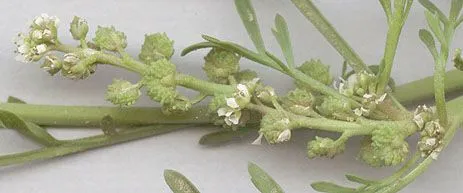
Author: (L.) Al-Shehbaz
Bibliography: Novon 14: 152 (2004)
Year: 2004
Status: accepted
Rank: species
Genus: Lepidium
Vegetable: False
Observations: Macaronesia, Europe to C. Asia
Creeping wart cress, scientifically known as Lepidium coronopus, is a plant that belongs to the Brassicaceae family, notable for its wide distribution and adaptive versatility. Originally recognized and classified by Linnaeus and further elaborated upon by Al-Shehbaz in a 2004 publication in Novon, this species stands out for its distinctive growth habit and ecological significance.
Native to regions spanning from Macaronesia and Europe to Central Asia, Creeping wart cress has successfully adapted to various climates and soil conditions, showcasing its robust nature. Its ability to thrive in diverse environments is a testament to its resilience and ecological adaptability.
Characterized by its creeping growth form, this plant often forms dense mats on the soil surface. The leaves of Lepidium coronopus are typically elongated and somewhat warty, which is a trait that partly inspires its common name. This unique morphology not only aids in identification but also contributes to its effective ground-covering capability, which can inhibit the growth of competing vegetation and reduce soil erosion.
While it may often be overlooked due to its low-growing nature, Creeping wart cress plays an important role in its habitats. It serves as a valuable food source for various insects and wildlife, while also contributing to the biodiversity of the regions it inhabits. Due to its hardy nature, it can be an asset in land reclamation projects and in areas where soil stabilization is needed.
In summary, Lepidium coronopus is a resilient and ecologically significant member of the Brassicaceae family, appreciated both for its botanical characteristics and its practical benefits to the environments it colonizes.
Dan: almindelig ravnefod, ravnefod
Deu: gewöhnlicher krähenfuß, niederliegender knotenfuß
Eng: greater swinecress, creeping wart cress, crowfoot, greater swine cress, swine cress, swine-cress, common wart-cress, swine’s cress, carpetgrass, creeping wartcress, small-scaled swinecress
Fin: kaljuvariksenkrassi
Swe: kaljuvariksenkrassi, kråkkrassing, kråkfot, kråkkrasse
Nno: kråkekarse
Nob: kråkekarse
Nld: grove varkenskers
Fra: corne-de-cerf commune, corne de cerf écailleuse
Cym: berwr y moch, olbrain, olbrain dafadenuog, olfran
En: Creeping wart cress, Greater swine cress, Crowfoot, Swine cress, Greater swinecress, Creeping Watercress, Swine-cress, Common Wart-Cress, Swine’s Cress, Carpetgrass, Creeping wartcress, Small-scaled swinecress, Greater swine-cress, Swinecress
Ar: رشاد البحر (رَشاد البَحر)
Cs: Vranožka šupinatá
Da: Almindelig ravnefod, Ravnefod
Nl: Grove varkenskers
Fi: Kaljuvariksenkrassi, Ryhmykrassi
Fr: Pied-de-corneille, Corne-de-cerf commune, Corne de cerf écailleuse, Corne-de-cerf écailleuse, Sénebière Corne-de-cerf
De: Niederliegender Knotenfuß, Gewöhnlicher Krähenfuß, Niederliegender Krähenfuß
Nb: Kråkekarse
Nn: Kråkekarse
Pl: Wronóg grzebieniasty
Es: Cervellina, Polegla vranja noga
Sv: Kråkkrassing, Kaljuvariksenkrassi, Kråkfot, Kråkkrasse
Cy: Berwr y Moch, Olbrain, Olbrain Dafadenuog, Olfran
Taken Jan 1, 1900 by EOL − Encyclopedia of Life (cc-by-nc-sa)
Taken Jan 1, 1900 by EOL − Encyclopedia of Life (cc-by-nc-sa)
Taken Jan 1, 1900 by EOL − Encyclopedia of Life (cc-by-nc-sa)
Taken Jan 1, 1900 by EOL − Encyclopedia of Life (cc-by-nc-sa)
Taken Jan 1, 1900 by EOL − Encyclopedia of Life (cc-by-nc-sa)
Taken Aug 28, 2022 by Marelize Greeff-Garcia (cc-by-sa)
Taken Sep 23, 2022 by Ambre Matencio (cc-by-sa)
Taken Aug 28, 2022 by Marelize Greeff-Garcia (cc-by-sa)
Taken May 6, 2020 by santos Borja (cc-by-sa)
Taken Oct 13, 2021 by rachel thompson (cc-by-sa)
Taken Jan 1, 1900 by EOL − Encyclopedia of Life (cc-by-nc-sa)
Taken Jan 1, 1900 by EOL − Encyclopedia of Life (cc-by-nc-sa)
© copyright of the Board of Trustees of the Royal Botanic Gardens, Kew.
© copyright of the Board of Trustees of the Royal Botanic Gardens, Kew.
© copyright of the Board of Trustees of the Royal Botanic Gardens, Kew.
Family: Myrtaceae Author: (F.Muell.) K.D.Hill & L.A.S.Johnson Bibliography: Telopea 6: 402 (1995) Year: 1995 Status:…
Family: Rubiaceae Author: Pierre ex A.Froehner Bibliography: Notizbl. Bot. Gart. Berlin-Dahlem 1: 237 (1897) Year:…
Family: Sapindaceae Author: Koidz. Bibliography: J. Coll. Sci. Imp. Univ. Tokyo 32(1): 38 (1911) Year:…
Family: Asteraceae Author: A.Gray Bibliography: Pacif. Railr. Rep.: 107 (1857) Year: 1857 Status: accepted Rank:…
Family: Fabaceae Author: Medik. Bibliography: Vorles. Churpfälz. Phys.-Ökon. Ges. 2: 398 (1787) Year: 1787 Status:…
Family: Aspleniaceae Author: (Cav.) Alston Bibliography: Bull. Misc. Inform. Kew 1932: 309 (1932) Year: 1932…